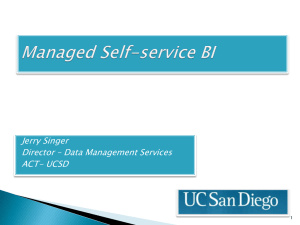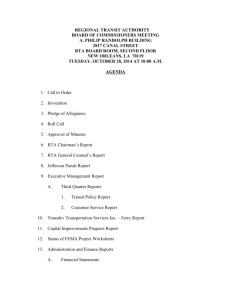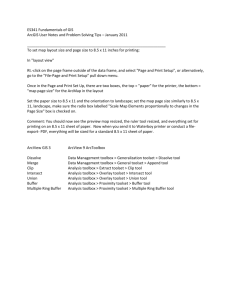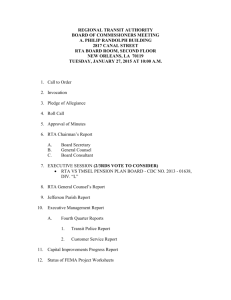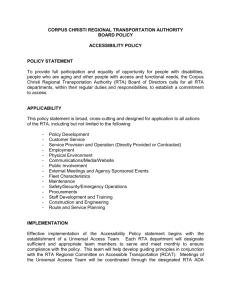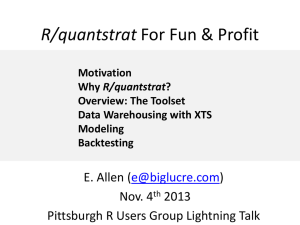Tools for monitoring of data exchange in real
advertisement
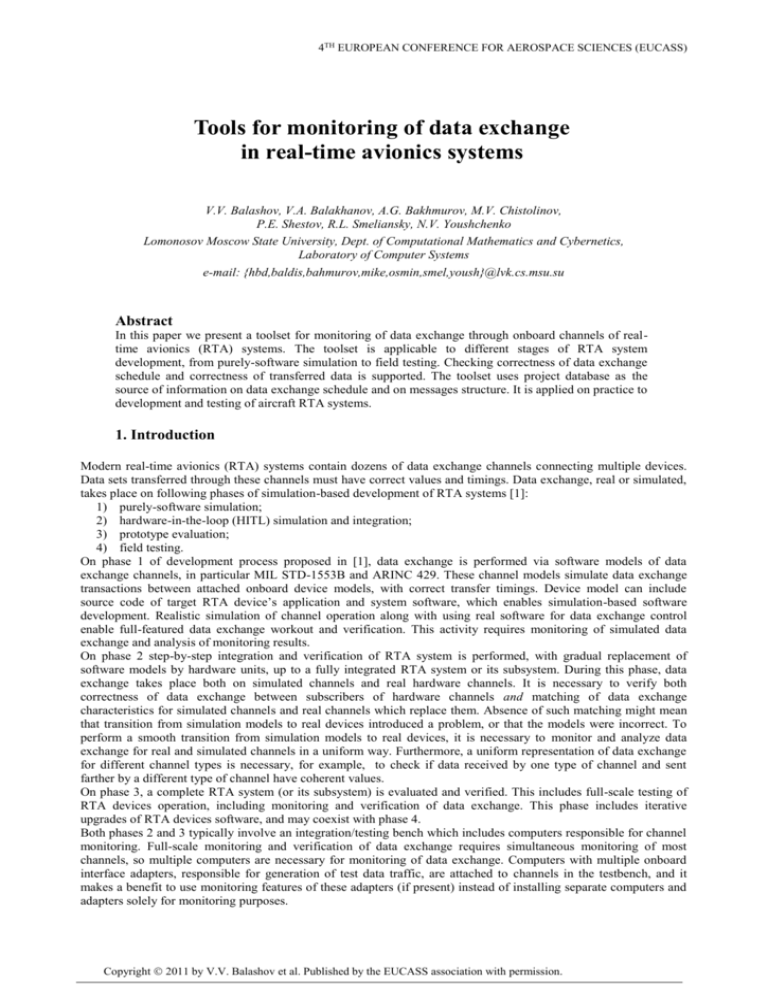
4TH EUROPEAN CONFERENCE FOR AEROSPACE SCIENCES (EUCASS)
Tools for monitoring of data exchange
in real-time avionics systems
V.V. Balashov, V.A. Balakhanov, A.G. Bakhmurov, M.V. Chistolinov,
P.E. Shestov, R.L. Smeliansky, N.V. Youshchenko
Lomonosov Moscow State University, Dept. of Computational Mathematics and Cybernetics,
Laboratory of Computer Systems
e-mail: {hbd,baldis,bahmurov,mike,osmin,smel,yoush}@lvk.cs.msu.su
Abstract
In this paper we present a toolset for monitoring of data exchange through onboard channels of realtime avionics (RTA) systems. The toolset is applicable to different stages of RTA system
development, from purely-software simulation to field testing. Checking correctness of data exchange
schedule and correctness of transferred data is supported. The toolset uses project database as the
source of information on data exchange schedule and on messages structure. It is applied on practice to
development and testing of aircraft RTA systems.
1. Introduction
Modern real-time avionics (RTA) systems contain dozens of data exchange channels connecting multiple devices.
Data sets transferred through these channels must have correct values and timings. Data exchange, real or simulated,
takes place on following phases of simulation-based development of RTA systems [1]:
1) purely-software simulation;
2) hardware-in-the-loop (HITL) simulation and integration;
3) prototype evaluation;
4) field testing.
On phase 1 of development process proposed in [1], data exchange is performed via software models of data
exchange channels, in particular MIL STD-1553B and ARINC 429. These channel models simulate data exchange
transactions between attached onboard device models, with correct transfer timings. Device model can include
source code of target RTA device’s application and system software, which enables simulation-based software
development. Realistic simulation of channel operation along with using real software for data exchange control
enable full-featured data exchange workout and verification. This activity requires monitoring of simulated data
exchange and analysis of monitoring results.
On phase 2 step-by-step integration and verification of RTA system is performed, with gradual replacement of
software models by hardware units, up to a fully integrated RTA system or its subsystem. During this phase, data
exchange takes place both on simulated channels and real hardware channels. It is necessary to verify both
correctness of data exchange between subscribers of hardware channels and matching of data exchange
characteristics for simulated channels and real channels which replace them. Absence of such matching might mean
that transition from simulation models to real devices introduced a problem, or that the models were incorrect. To
perform a smooth transition from simulation models to real devices, it is necessary to monitor and analyze data
exchange for real and simulated channels in a uniform way. Furthermore, a uniform representation of data exchange
for different channel types is necessary, for example, to check if data received by one type of channel and sent
farther by a different type of channel have coherent values.
On phase 3, a complete RTA system (or its subsystem) is evaluated and verified. This includes full-scale testing of
RTA devices operation, including monitoring and verification of data exchange. This phase includes iterative
upgrades of RTA devices software, and may coexist with phase 4.
Both phases 2 and 3 typically involve an integration/testing bench which includes computers responsible for channel
monitoring. Full-scale monitoring and verification of data exchange requires simultaneous monitoring of most
channels, so multiple computers are necessary for monitoring of data exchange. Computers with multiple onboard
interface adapters, responsible for generation of test data traffic, are attached to channels in the testbench, and it
makes a benefit to use monitoring features of these adapters (if present) instead of installing separate computers and
adapters solely for monitoring purposes.
Copyright 2011 by V.V. Balashov et al. Published by the EUCASS association with permission.
FLIGHT DYNAMICS, GNC AND AVIONICS FOR SPACE AND AERONAUTICAL APPLICATIONS
On phase 4, a real RTA system installed on a (prototype of) controlled system, e.g. an aircraft, is tested. A mobile
monitoring solution is necessary to examine the data exchange. Such examination is essential as no technological
software stubs are allowed to provide extra information on what is going on inside the RTA devices. Such solution
can be farther used during field operation phase in case the controlled system does not have tight constraints on mass
and size of “extra” load; for instance, it is acceptable to take a compact mobile monitoring device onboard a ship or a
heavy transport aircraft. As RTA system developers are not typically available on-site during field operation, it is
necessary to support long-lasting monitoring process (for several days at minimum).
On all phases of RTA system development process mentioned above, data exchange specifications (message formats,
schedules etc) are taken from a project database.
A single solution is necessary to support data exchange monitoring and analysis on all four phases of the process.
Requirements to this solution are as follows:
1) support for monitoring of different types of channels present in RTA system, with uniform representation of
monitoring results and unified capabilities for analysis of these results;
2) support for monitoring of both real and simulated channels;
3) integration with project database as a source of data exchange specifications;
4) support for following configurations:
- software only installation for working with a purely software simulation model of RTA system on early
development phases;
- stationary multi-computer system (a part of testbench) controlled from a single workstation; sharing of
channel adapters with test traffic generating computers is a favorable feature;
- compact mobile platform (e.g. a rugged notebook) for use during field testing and field operation.
This paper presents a software toolset for data exchange monitoring which suits all the requirements listed above and
provides a wide range of features to support data exchange monitoring and analysis. This toolset is developed in the
Computer Systems Laboratory (CS Lab) of Computational Mathematics and Cybernetics department of the Moscow
State University.
The rest of the paper is organized as follows. Section 2 presents an overview of several existing monitoring solutions,
including the presented toolset, and compares their feature sets. In particular the toolsets are checked for
conformance to requirements 1-4. Section 3 describes structure of the presented toolset. Section 4 presents the
workflow for application of the toolset. Section 5 contains two case studies. In the last section, future directions of
work are proposed.
2. Related work
In this section we list several examples of monitoring toolsets provided by different vendors and assess their feature
sets with special attention to support of requirements 1 – 4 from Section 1. The scope of analysis is limited to
MIL STD-1553B and ARINC 429 channels as they are most widely used in today's military avionics [2].
The toolsets of interest are as follows:
PBA.pro from AIM GmbH [3];
CoPilot from Ballard Technology [4];
DataSIMS from DDC [5];
MIL-1553 Tester from Elcus [6];
Flight Simulyzer from AIT [7];
ADS2 from TechSAT GmbH [8];
Luthier from Sital Technology [9];
BusTools from General Electric [10];
Exalt+ from Excalibur Systems [11];
IMUX G2 from Wyle [12];
MIL STD-1553B and ARINC 429 Analyzer, introduced in this paper.
Overview results are summarized in Table 1. Analysis of feature sets reveals following main features of monitoring
tools, in addition to listed in Section 1:
Unpacking parameters from recorded data blocks ("Par" column in Table 1);
MIL STD-1553B terminal devices management, including setting/viewing subaddress data ("RT" column);
MIL STD-1553B bus controller (and ARINC 429 sender) management, including exchange sequence
specification and execution ("BC" column);
Recording and display of data exchange traces ("Rec" column);
Replay of registered exchange ("Rpl" column);
Fault injection into channel ("FI" column);
2
V.V. Balashov et al. Tools for monitoring of data exchange in real-time avionics systems
Recording start/stop on specified events during data exchange ("Ev" column).
Support for a mobile platform is typical for the reviewed tools (provided that the computer is powerful enough, and
there are extension slots for adapter cards). If a monitoring toolset supports both MIL STD-1553B and ARINC 429,
it usually represents monitoring results in a uniform way for both channel types. Considering this, specific features
related to requirements 1-4 from Section 1 are as follows:
support for monitoring of both real and simulated channels ("Sim" column); the latter implies support for
software only configurations;
integration with project database ("DB" column);
support for a stationary multi-computer system (a part of testbench) controlled from a single workstation
("MCS" column);
sharing of channel adapters with test traffic generating computers of a testbench ("SHR" column).
Table 1. Monitoring toolsets capabilities
Toolset name
Supported
channel types
M1553, A429,
FC-AE, ADFX,
CAN, Panavia
M1553, A429,
AFDX, A708
Par
RT
BC
Rec
Rpl
FI
Ev
Sim
DB
MCS
SHR
+
+/-
+
+
-
+
+
-
-
-
+/-
+
+
+
+
+
+
-
-
-
-
-
DataSIMS
M1553, A429
+
+
+
+
+
+
+
-
-
-
-
MIL-1553
Tester
M1553
-
-
-
+
-
-
-
-
-
-
-
Flight
Simulyzer
M1553, A429
-
+
+
+
-
+
-
-
-
+
-
ADS2
M1553, A429,
AFDX, CAN, …
+
+
+
+
-
+
+
-
+
+
+/-
Luthier
M1553
-
+
+
+
-
-
-
-
-
-
-
BusTools
M1553, A429,
AFDX
+
+
+
+
-
+
+
-
-
-
-
Exalt+
M1553, A429,
A708,AFDX,...
+
+/-
+
+
-
+
+
-
-
-
-
IMUX G2
M1553, A429,
A624, FC-AE, ...
+
-
-
+
-
-
-
-
+
+
+/-
MIL STD1553B and
ARINC 429
Analyzer
M1553, A429
*
+
+
+
-
-
-
+
*
+
+
PBA.pro
CoPilot
Notes for Table 1.
"+/-" for RT management feature means that only RT and subaddress status flags management is supported,
but not setting up data for RT subaddresses;
"+/-" for hardware adapter sharing between testing and monitoring tools means that this toolset supports
both testing and monitoring functions, but it is unclear from available documentation whether adapter
sharing is supported;
"*" means that the feature implementation is on schedule.
The overview shows that the most full-featured toolsets like PBA.Pro, DataSIMS, ADS2 "as is" cannot support
simulation-based development of RTA systems [1] on phases 1 and 2 which involve data exchange through
simulated channels, and most toolsets do not support multiple computer configurations controlled from a single
workstation. The proposed toolset lacks some of "common" features but is designed for full support of all four phases
of the process [1] (see Section 1).
3
FLIGHT DYNAMICS, GNC AND AVIONICS FOR SPACE AND AERONAUTICAL APPLICATIONS
3. Monitoring toolset structure
Figure 1 show the structure of the presented monitoring toolset in multiple computer configuration.
Project
database
Hard disk
User interface
Workstation
Subsystem for data
recording and
agent interaction
Data
correctness
checking
subsystem
Monitoring agent
Recorder
PC
Driver
Driver
MIL-1553B
adapter
ARINC 429
adapter
Figure 1. Monitoring toolset structure
Resident module of the toolset runs on a recorder PC (REC PC) and includes:
adapter drivers;
monitoring agent responsible for interaction between user-controlled workstation module and adapter
drivers.
REC PC includes channel adapters supporting sender/receiver/monitor functions (ARINC 429), bus
controller/remote terminal(s)/bus monitor functions (MIL STD-1553B); for each channel type, the adapter may
support one or several functions at once. Monitoring toolset is optimized for specific channel adapter cards produced
by Elcus company and Space Research Institute, Russia.
Adapter drivers are built to enable multiple non-blocking access to adapters performing receive-only functions
(channels monitors, ARINC 429 receivers), and independent (though blocking) use of remote terminals (RT) on
multi-RT MIL STD-1553B adapters and of output channels on ARINC 429 channels with many such channels. This
enables cooperative use of PCs and adapters by monitoring tools and by hardware-in-the-loop integration/testing
toolset [1]. Drivers also perform pre-filtering of received data according to user-specified criteria in order to optimize
traffic to workstation and recorded trace size (which is crucial for long-run recording). Simulation of MIL STD1553B and ARINC 429 channels is implemented by specialized drivers of "virtual" channel adapters.
Monitoring agent, in addition to interaction support functions, supports execution of complex data exchange
schedules, for instance those constructed by Scheduler CAD tool [13]. As adapter cards support end-to-end execution
for single exchange chain only, the monitoring agent performs real-time reloading of exchange chains to bus
controller cards.
Workstation module of the toolset runs on a workstation PC (WS PC). A single instance of this module running on a
WS PC can control monitoring agents on several REC PCs. Workstation module includes:
subsystem for recording of data received from agents, and for interaction with agents;
subsystem for checking correctness of recorded data;
4
V.V. Balashov et al. Tools for monitoring of data exchange in real-time avionics systems
user interface.
Data recording subsystem writes the received data to a hard disk (splitting them into chunks of specified duration)
and reads the previously recorded data to be displayed in GUI. During online monitoring, data bypass the recording
phase and are displayed in GUI in real time (writing to a disk is performed concurrently).
Data correctness checking subsystem supports on-the-fly testing of received data against correctness constraints,
such as belonging to specified ranges, conformance to smoothness requirements, correlation of data values
transferred through duplicated channels etc. Data correctness check is performed on parameter values unpacked from
recorded messages; unpacking is performed according to message structure specification which is entered by the user
or imported from the project database. There is also an option to check the recorded exchange sequence for
conformance to a specified exchange schedule.
User interface represents the monitoring results in following forms:
parameter-oriented views, displaying unpacked parameters in table and graph forms;
exchange-oriented views:
- exchange log;
- exchange statistics (including error statistics), calculated for different addresses and subaddresses
separately;
- last recorded exchange for each sender-receiver pair (MIL STD-1553B) or word address (ARINC
429);
user controls for operation with:
- MIL STD-1553B bus controller and ARINC 429 data sender, including exchange schedule
specification;
- MIL STD-1553B remote terminals, including setting up and viewing data for subaddresses;
tools for setting up filters for data recording and display;
tools for data search.
Integration of workstation module of the toolset with project database is in progress. Database integration enables
import of messages structure and exchange schedule specifications from the database.
In mobile installation of the toolset, workstation PC and recorder PC is the same computer (a rugged notebook).
4. Workflow for toolset application
In this section we describe the workflow for application of the presented monitoring toolset as a part of simulationbased integration workflow proposed in [1]. The workflow from [1] includes following steps:
1) filling the RTA system project database with data on the system structure, on protocols and formats of data
exchange between devices;
2) automated generation of interface sections of the RTA system device models (including input and output
parameters, interfaces of models with channels, interconnections between models);
3) implementation of the functionality logic for models of the devices that are not yet available in hardware, on
one of the levels of detail:
a) detailed implementation that includes source code of device’s software;
b) simplified implementation, imitating external behaviour of the device;
4) automatic construction of schedules of data exchange for MIL STD-1553B channels (by means of
Scheduler CAD);
5) automatic generation of code for schedule definition in the following formats:
a) unified format for target devices and device models, recognizable by the code of system tasks running
either on models or on real devices;
b) specialized format for simplified models which do not contain code of system tasks;
6) automatic generation of code for message packing and unpacking in the following formats:
a) unified format for target devices and device models;
b) specialized format for simplified models;
7) integration of generated code into the models and available real RTA system devices;
8) preparation of the testbench hardware, in particular connecting instrumental computers and available RTA
system devices to the data exchange channels;
9) defining the configuration of the testbench: distribution of models to instrumental computers, settings for
channel monitoring and for registration of simulation events;
10) performing the simulation with a given set of hardware RTA system devices and device models;
11) analysis of simulation results, including automated verification of conformance of the recorded data
exchange sequences to reference exchange schedules from the project database.
5
FLIGHT DYNAMICS, GNC AND AVIONICS FOR SPACE AND AERONAUTICAL APPLICATIONS
Monitoring toolset is involved at following steps:
steps 1 and 4: input data for the toolset are entered into the project database;
step 8: hardware (including REC PCs and adapters) is set up for use by resident module of the monitoring
toolset;
step 9: binding of “logical” channels to specific adapters on REC PCs is defined; data exchange
specifications are loaded from the project database into the workstation module of the toolset;
step 10: during simulation, the monitoring tools record and analyze the data exchange through real and
simulated channels;
step 11: the user performs offline analysis of monitoring results.
If there are no hardware devices available on the current stage of RTA system development, steps 7-11 involve only
simulation models of the devices and constitute a process of “virtual” integration. During this process, real source
code for the devices and real exchange schedules are validated via testbench and monitoring tools.
Application of monitoring toolset during in-field testing and operation of RTA system is generally the same,
however on all steps involving monitoring toolset a real RTA system and a mobile monitoring solution are used. For
in-field operation, step 10 may be long-lasting, and step 11 may require delivery of collected recording results to an
engineering laboratory for analysis.
5. Case studies
Two industrial case studies for monitoring toolset application are considered below.
Stationary monitoring solution for integration/testing bench. In 2009, a testbench for integration and testing of
aircraft RTA systems was created and accepted for operation. This testbench includes several instrumental computers
equipped with MIL STD-1553B and ARINC 429 adapters, and workstations. Instrumental computers perform
functional and integration testing activities under control from workstations, generating test data traffic and checking
responses from RTA system devices. Instrumental computers are also capable of running simulation models of
unavailable RTA system devices. Monitoring toolset's resident modules are installed on all instrumental computers,
and onboard interface adapters are shared between testing and monitoring tools. Monitoring tools can be used either
as a source of information on data exchange between RTA system devices and instrumental computers (e.g. for test
or model debugging purposes), or as a standalone facility for generation of simple traffic for RTA system devices in
course of development of devices' source code. In both cases, the online monitoring functions are mostly used. The
testbench is connected to a server which hosts the project database to enable automatic import of data from the
database.
Mobile monitoring solution for in-field testing. This solution is currently under development. It is based on a
rugged notebook with several USB-attached MIL STD-1553B adapters and intended for long-run recording of data
exchange for naval RTA systems. The focus is on detecting exchange errors and deviation of transferred parameter
values from given specifications. The user performs mainly offline analysis activities.
6. Conclusion
In this paper we presented a toolset for monitoring of data exchange on MIL STD-1553B and ARINC 429 channels
in real-time avionics systems. This toolset supports different phases of simulation-based RTA system development
process proposed in [1]. Two industrial case studies of toolset application were considered.
Directions for future development of the monitoring toolset include:
completion and delivery for operation of the mobile monitoring solution;
development of monitoring solution for high-speed Fibre Channel bus;
development of scripting subsystem for specification of user-defined constraints on correctness of
transferred data.
References
[1] Balashov, V.V., Bakhmurov, A.G., Chistolinov, M.V., Smeliansky, R.L., Volkanov, D.Y. and Youshchenko,
N.V. A hardware-in-the-loop simulation environment for real-time systems development and architecture
evaluation. Int. J. Critical Computer-Based Systems. 2010, Vol. 1, No. 1/2/3: 5–23.
[2] Guide to digital interface standards for military avionics applications. Technical report ASSC/110/6/2-Issue 3,
Avionics Systems Standardization Committee, 2006.
[3] PBA.pro homepage. Obtained through Internet: http://www.aim-online.com/products/software/pba-pro.aspx,
[accessed 1/06/2011].
6
V.V. Balashov et al. Tools for monitoring of data exchange in real-time avionics systems
[4] CoPilot
Software.
The
Ultimate
Databus
Analyzer.
Obtained
through
Internet:
http://www.ballardtech.com/products.aspx/CoPilot/, [accessed 1/06/2011].
[5] dataSIMS Avionics Data Bus Test and Analysis Software. Obtained through Internet: http://www.ddcweb.com/Products/51/Default.aspx, [accessed 1/06/2011].
[6] MIL STD-1553B tester software . Obtained through Internet: http://www.elcus.ru/swtester1553.htm [in
Russian], [accessed 1/06/2011].
[7] 1553
Flight
Simulyzer
GUI
Analyzer
Software.
Obtained
through
Internet:
http://www.aviftech.com/igsbase/igstemplate.cfm/SRC=DB/SRCN=/GnavID=3/SnavID=59/TnavID=173,
[accessed 1/06/2011].
[8] ADS2
Avionics
Development
System
2nd
Generation.
Obtained
through
Internet:
http://www.techsat.com/products/software/ads2.html, [accessed 1/06/2011].
[9] Luthier™ - User-Friendly Software for Creating 1553 Communications. Obtained through Internet:
http://www.sitaltech.com/Luthier.asp, [accessed 1/06/2011].
[10] GE Intelligent Platforms. Data Bus Analyzers. Obtained through Internet: http://defense.geip.com/products/family/data-bus-analyzers, [accessed 1/06/2011].
[11] Exalt Plus – Excalibur Analysis Laboratory Tools. Obtained through Internet: http://www.mil1553.com/Excalibur08/Templates/showpage.asp?
DBID=1&LNGID=1&TMID=108&FID=229&PID=242&IID=223, [accessed 1/06/2011].
[12] IMUX
G2.
The
Intelligent
Recording
Solution.
Obtained
through
Internet:
http://www.wyle.com/PDFs/archive/IMUX_G2.pdf, [accessed 1/06/2011].
[13] Balashov, V.V., Balakhanov, V.A., Kostenko, V.A., Smeliansky, R.L., Kokarev, V.A., Shestov, P.E.
'A technology for scheduling of data exchange over bus with centralized control in onboard avionics systems',
Proc. Inst. Mechanical Engineering, Part G: J. Aerospace Engineering. 2010, Vol. 224, No. 9: 993–1004.
7
